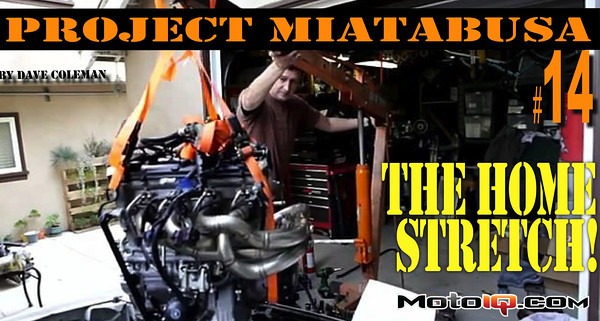
Hope you enjoyed yesterday's tasty donuts. Now here are a bunch of details that have delayed the making of stinky donuts:
At the end of the aluminum exhaust fab project, we wanted to hear our new creation, but the starter wouldn't cooperate. Though we thought we had finally solved the Miatabusa's complex starter problem, the starter we installed was built from used parts salvaged from a few broken starters. Any guesses what happens when you build with broken parts? You get another broken starter.
Though it worked on the bench, once we installed it in the car, the engine could only turn over until the first or second compression stroke before the one-way sprag clutch (the one that lets the engine outrun the starter when it finally catches) started to slip and the engine stopped while the starter motor freewheeled.
Undaunted, we decided to push start the car. Only we couldn't. Even with a foot firmly on the clutch, and the clutch hydraulics thoroughly diagnosed, the car acted like it was in gear. The clutch simply wouldn't disengage.
So we push started it with Alex's M-Coupe (backwards, since the Z3 body has too pointy a front bumper, and the Miata's front bumper cover was off anyway.) It fired immediately, and sounded like this:
The stuck-in-gear thing seemed to sort itself out immediately, but a few other problems arose. First, there was this horrendous oil leak, made much more obvious by the fluorescent goo we used to trace it.

Then there was the nasty rattling noise of the engine hitting the subframe. And, of course, the sad fact that we had built the starter in a way that made it impossible to change without removing the bellhousing. Time for the engine to come back out and remedy those problems, but not before several unrelated delays caused by the day job and the Frankenmiata.

The massive oil leak, it turns out, was caused by our attempts to prevent a massive oil leak. Let me explain…
The bellhousing adaptor we fabricated bolts to two different parts of the Hayabusa engine case. The wedge piece, shown here, bolts to the angled clutch cover face, and then the bellhousing adaptor bolts to both the wedge and the crank nose cover at the same time. To make this work, both these surfaces seed to be at the same height and perfectly parallel. That's not actually all that hard to do, with the right laser scanners, CAD tools and machining skillz, if (and believe me, it's a big IF) the Hayabusa engine cases can be trusted to be consistent.
We don't trust them though. Odds are pretty good the two faces are machined separately, on different machines in different setups. Both faces need to be flat, but neither needs to be a precise height relative to the other, since both covers are independent and don't attach to anything else. If Suzuki didn't need to keep them consistent to a thousandth of an inch, it would be foolish to assume they did.
So we didn't. Tim machined the wedge a few thousandths short, and we used a shim to bring it up to the same height as the crank cover. This strategy let us track which shims each Hayabusa engine required. Over time, if every engine requires the same shim, we'll know Suzuki kept these faces consistent, and we can start making wedges to the right height. If not, we just use a different shim for each engine.

Problem is, we somehow started with the wrong shim. The fluorescent goo clearly showed the oil leak was gushing from the crank nose flange, and when I measured the height of the bellhousing flange's two mating surfaces (the black bit is a precision straightedge), there was a 0.009 gap at the crank flange. Final assembly had happened in a furiously busy weekend, and the old measure twice, shim once strategy had been mixed up.



